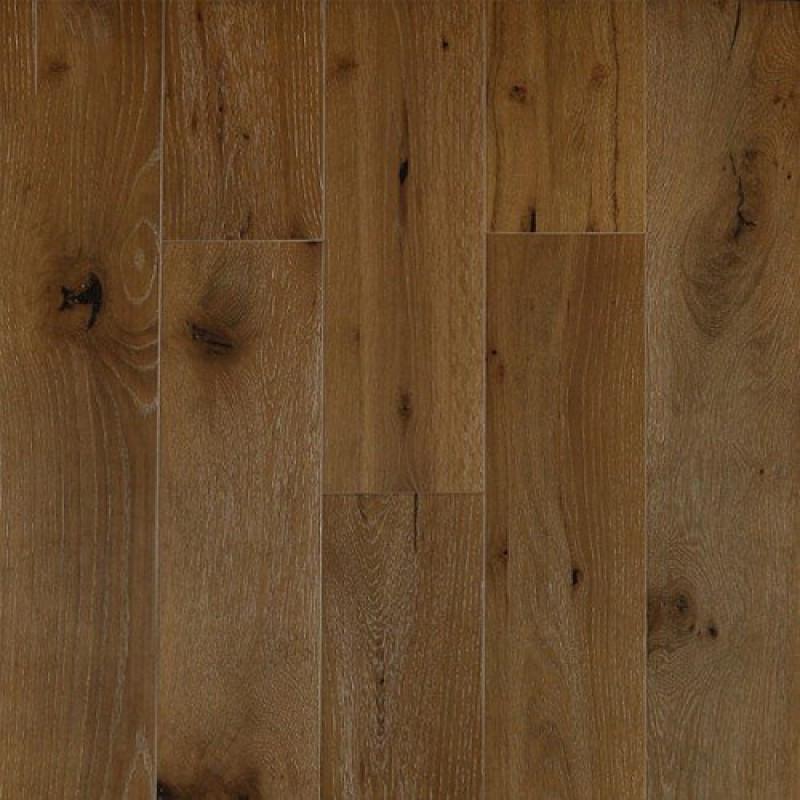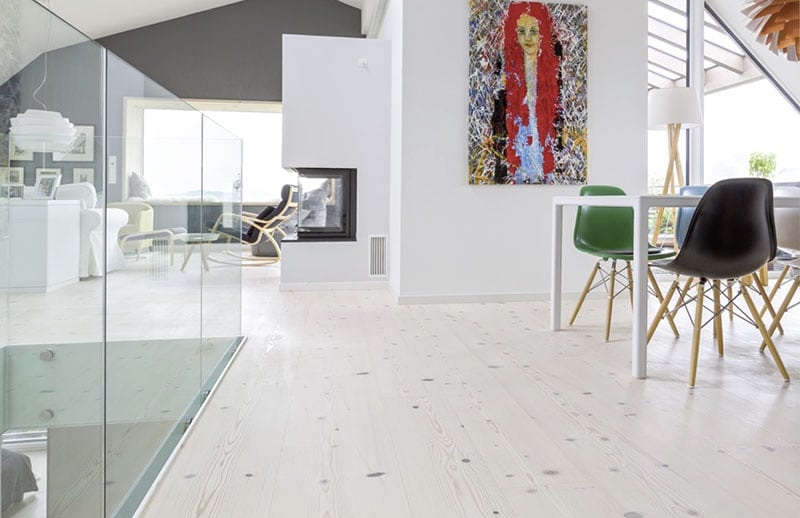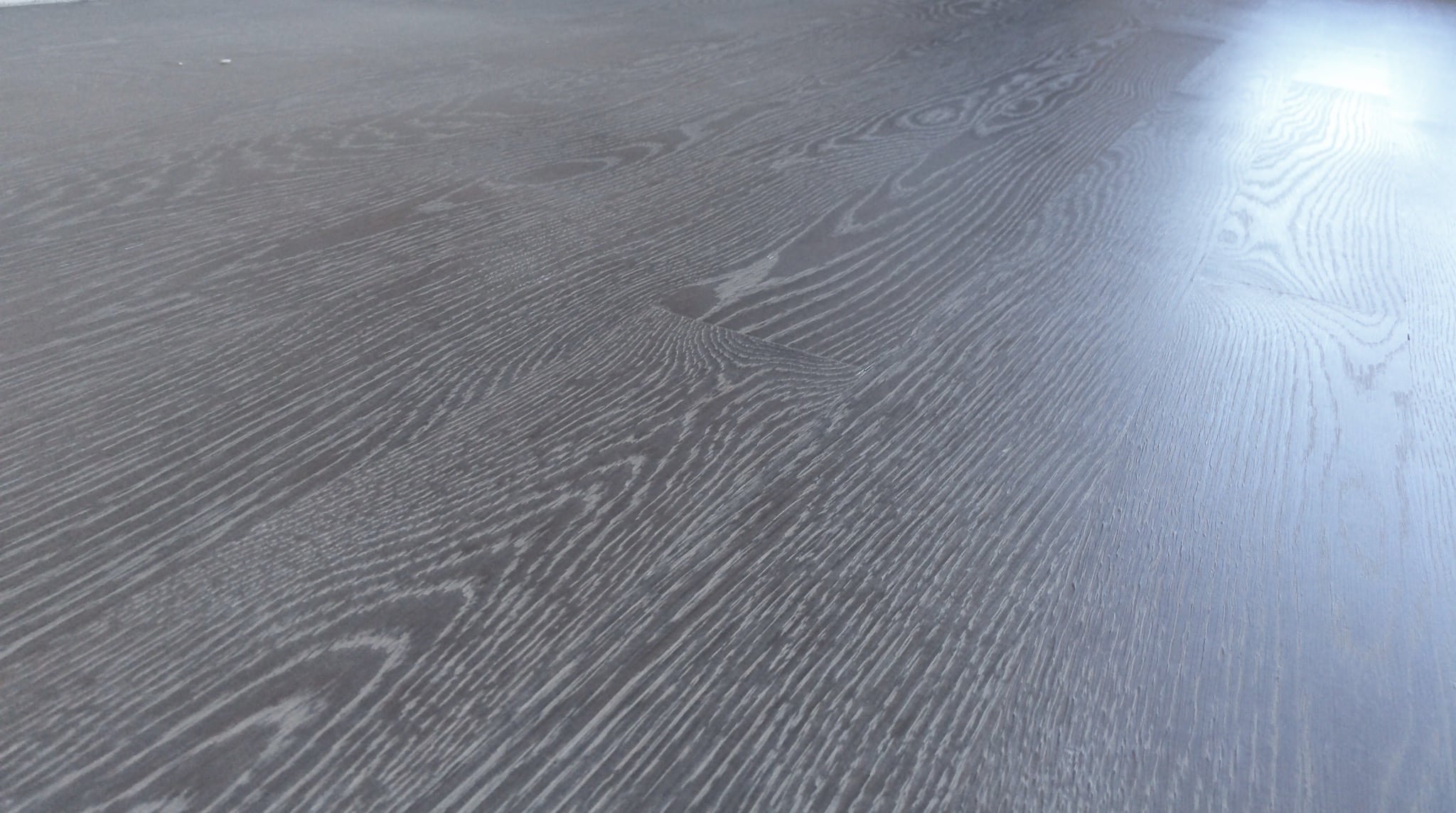- November 20, 2017
- Posted by: Dustin Rhodes
- Category: Rhodes Hardwood News
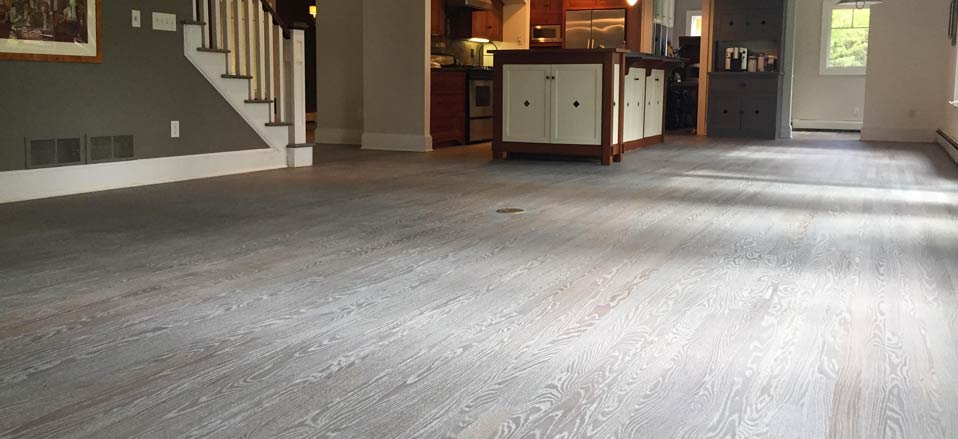
Hardwood Flooring Reactive Stains + Dyes
Rhodes Hardwood is one of the most well versed wood flooring companies in the US with regard to custom finishing of wood floors.
One of the techniques we use in creating one of a kind custom floors is wood reactive products. Wood Reactive’s alter the color + look of wood through a reaction that occurs when certain solutions come in contact with it. These various wood reactives can create a wide variety of colors and looks including; bleaching or whitening wood, greying it, aging it, distressing it, and giving new wood a reclaimed or weathered driftwood sort of look. Reactive’s can also create textured looks and add depth of color when other stains or finishes are applied after them.
Those we work with generally don’t contact us knowing that they want us to use a reactive. Rather, they’ll often know the look that they wish to achieve and while we’re making samples to find how we can achieve the look, we’ll often find that a reactive will help us to get the look they desire.
The purpose of the information we’re providing here isn’t to let you know if you need a reactive or not, it’s to simply elaborate on the depth of our wood finishing knowledge so potential clients can better understand what makes our company a great choice for custom hardwood floors and to offer the public and other wood finishers some great information on the subject.
History of wood reactives
Reactive’s and wood date back a very long time and most were discovered on accident. It is said that the process of ammonia fuming was discovered in England after someone took notice to oak boards darkening from horse urine and the ammonia that’s present in it. Renowned furniture maker Stickley then introduced this process to the US in 1901 when he unveiled wood furniture with a totally unique look that people hadn’t previously seen.
Today, we thankfully have ways of creating a reaction on wood without having to have a horse pee on it ?. In fact, some of the techniques that we use are non-toxic. In recent years some manufacturers of wood finishes have started selling these products pre-made and ready to use.
Our company was exploring various ways to alter the look of wood and various finishing techniques long before products were offered for this purpose. Pushing the design limits with wood finishing has been of interest to us since we’ve been working with wood. We’ve spent a lot of time and much trial and error teaching ourselves how to apply various old world wood finishing techniques to an entire wood floor. Our workshop looks like it could be a laboratory with all of the flasks, mixers, 100’s of labeled solutions etc.
The science behind reactives
The reason that various solutions can alter a wood’s color is the presence of tannic acid in wood. Tannic acid naturally reacts with certain chemical solutions. Some wood species have a higher content of tannic acid than others, so different woods react in different ways when they come into contact with a various reactive. For example; white oak has a very high content of tannic acid and therefore it reacts very well with these products while woods such as maple, have a low content and don’t have much of a reaction. If you have a wood that is low in tannic acid, don’t fear because we even have a technique that allows us to add tannic acid to the wood. We’ll elaborate on this more below.
Reactive products + the results
Below we have listed some of the options for reactive products, the science behind how they work and the results that each produces.
Fuming
Fuming traditionally, was what furniture maker Stickley referred to as the reaction he achieved by ammonia fuming wood. He did this on many of his furniture pieces by putting them inside of a tent with ammonia, the vapors from the ammonia would alter the color of the wood. Today, companies that manufacture reactive’s refer to fuming as the reactive that greys wood.
One of our preferred finish manufacturers, Rubio Monocoat® makes a product called Fume specifically for this purpose.
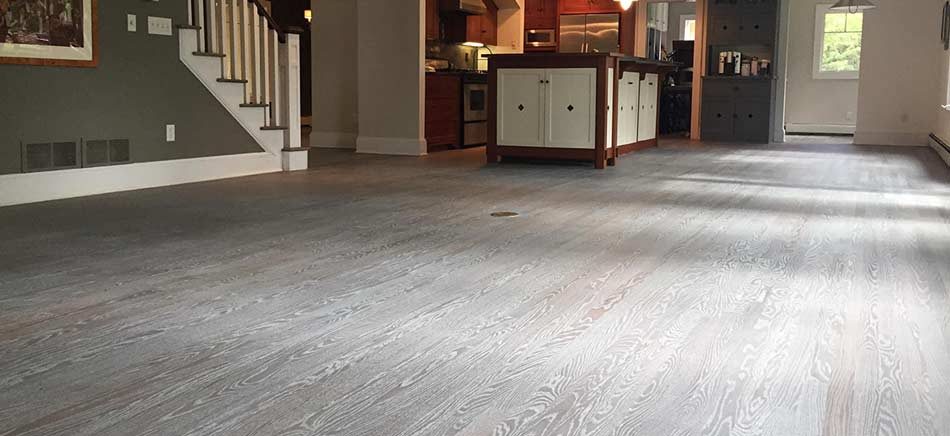
Rubio Monocoat® Fume
The composition of the fumed or graying reactive is ferrous sulfate (FeSO4). Ferrous sulfate is an iron supplement that’s essential for the human body and it’s non-toxic. Oftentimes people create a similar effect by using ferrous acetate (C14H27Fe3O18) this is often times made by simply mixing vinegar and steel wool together, the result of which is iron acetate (C14H27Fe3O18). Online in diy forums, on woodworking websites etc their is lots of discussion about this method and it being the way to get the fumed reaction with wood. We’ve even seen an article in one of the top publications of our niche and videos discussing this. All of this in our opinion, isn’t the greatest information.
Although iron acetate will achieve a reaction on wood and it may work for someone with a few boards or a table to do, we feel that making it with vinegar and steel wool is bad information (especially for those trying to do this to an entire wood floor) because it involves way too many scientific variables to work effectively and to consistently make a solution that reacts the same way each time you use it. In our line of work we need to ensure that a sample that we show a client accurately reflects how their floor will look.
Years ago we found a much more accurate way of making a fuming solution that eliminates all of the scientific variables necessary to consistently make a steel wool /vinegar blend. This method is easier to make, more accurate, and cheaper.
Making an accurate fuming solution
Ferrous Sulfate – To make a ferrous sulfate solution you simply purchase some ferrous sulfate powder (readily available online) and mix it with water. Use some test boards to help dial in the exact blend that works for the look you desire.
Ferrous Acetate – Although we prefer the ferrous sulfate blend to grey wood, ferrous acetate also works. To make ferrous acetate you simply get S100 grade Iron Powder which is readily available online and mix it with a strong pickling vinegar (7% acetic acid). This works better than steel wool/vinegar by minimizing the scientific variables needed to make a solution that is the same every time you make it. Simply weigh the iron powder and measure the quantity of vinegar and use some sample boards to dial in the look you desire.
Some looks that can be achieved on wood by fuming include;
Grey wood– The tone of grey can be dialed in by adjusting the amount of ferrous sulfate to water.
For achieving more depth with a stain color – when you change the color tone of wood with a reactive prior to staining or using a colored finish, it results in more depth of color.
For creating a textured or ceruse look – when you fume wood and then apply a colored hardwax oil it can make the grain of the wood a different color thus creating a ceruse effect.
For those that want to make new wood look like an aged/greyed barn wood. This can be done to wood fencing, decking, wall paneling etc.
Smoke / Smoking
Smoking wood creates an aged or distressed sort of look by darkening it. As with the fume product mentioned above, Rubio Monocoat® also makes a pre-made solution called “Smoke” for this exact purpose.
Rubio Monocoat® Smoke
Smoking wood is achieved through the reaction of lye, aka sodium hydroxide (NaOH) with the tannic acid present in the wood. Sodium Hydroxide is used in making soap and it’s found in many household products. It is caustic so we recommend researching safe ways to handle and use it prior to doing so.
Making a wood lye / smoking solution
Smoking solution for wood floors is made by combining sodium hydroxide powder with warm water. The sodium hydroxide is added to the water very slowly and over a 30 minute+ timeframe. You can find sodium hydroxide on Amazon, or many drain cleaning powders are also made up of it. Again, this solution is caustic and can be harmful so we highly recommend doing some in depth research prior to making or using it.
Our company uses both Rubio Monocoat® Smoke as well as making our own. Making our own allows us to control the exact extent of the reaction. You can also adjust Rubio Monocoat® product by simply diluting it with water.
Some looks that can be achieved by smoking wood include;
- An aged look (by finishing with a clear finish or another color finish that compliments it)
- For achieving more depth with a stain color – when you change the color tone of wood with a reactive prior to staining, it results in more depth of color.
- For creating a textured or ceruse look – when you smoke wood and then apply a colored hardwax oil it can make the grain of the wood a different color this creating a ceruse look.
- For those that wish to give new wood a reclaimed or distressed look or for aging the wood. This can be done with wood fencing, paneling / cladding, wood furniture etc.
Bleaching
Bleaching hardwood floors is just as it sounds, it whitens the wood. Their are a few various solutions that can bleach wood including; Ocilitic acid, chlorine bleach, and 2 part wood bleaches. We have found that ocalitic acid and chlorine bleach have very little effect on bleaching the wood, so we generally use the 2 part bleach method as we’ve found that it’s very effective in bleaching wood.
2 part wood bleaches are comprised of Hydrogen Peroxide (H2O2) and Sodium Hydroxide (NaOH). When combined these create sodium hydroperoxide.
PLEASE NOTE: 2 Part wood bleaches are caustic and these chemicals can explode, so we highly recommend doing a lot of research prior to attempting to bleach wood.
Procuring a 2 part wood bleach
Because 2 part wood bleaches are caustic and can be dangerous to work with these are not readily available and very few retailers sell them online. I believe the reason that it’s not often shipped is because it’s considered hazardous. So your best bet is to look for this locally. Some hardwood flooring distributors carry these and some wood working stores have them.
Making the bleach solution
2 part wood bleach can be made yourself but again it can be harmful and it could even explode. So the limited info included below regarding the making of wood bleach is NOT to be used as complete directions, but rather it’s information to help you understand what bleach is made of so you can do additional research if you’re considering making it yourself.
One part of the wood bleach is 27% Hydrogen Peroxide, this is not your typical household peroxide, but rather a much stronger formula. We typically get this from pool supply stores as they sell it for shocking swimming pools.
The 2nd part of the wood bleach as mentioned above is sodium hydroxide. Sodium Hydroxide powder can be obtained online, or found in some powdered drain cleaners at your local home improvement store. The sodium hydroxide is dissolved in water to create the 2nd part of the bleach solution.
Again, do not use this as a guide for making this, but rather a starting point to help you understand the chemical composition and results. Here is some great information on the topic as well as info on the potential dangers.
https://www.fpl.fs.fed.us/documnts/pdf2013/fpl_2013_hart001.pdf
Some looks that can be achieved by bleaching wood include;
- We often use bleaching on red oak for customers that wish to get a white washed sort of look on their red oak. This is effective because when you put a white color on red oak without it you’ll get a pink floor. So this whitens the wood first to tone down the red tones.
- For those that like the bleached / whitened look that bleaching achieves
- For those that have a darker colored wood that wish to lighten it
- For those wanting to whiten any type of wood ie; furniture, wall paneling, flooring, fencing, decking etc etc.
Wood Lye Reactive
Wood Lyes creates a variety of grey, white washed, aged / distressed looks. Wood floor finish manufacturer WOCA® offers a few various pre-made wood lyes including; an antiquing lye and driftwood grey + white lyes.
Lye reactions on wood are achieved through the reaction of lye, aka sodium hydroxide (NaOH) with the tannic acid present in the wood. Sodium Hydroxide is used in making soap and it’s found in many household products. It is caustic so we recommend that you do your homework before using it.
Making a wood lye solution
Lye solution for wood floors is made the same way as the smoke reactive listed above is made by combining sodium hydroxide powder with warm water. The difference between lye and the smoke reactive is the lye has water soluble dye added to it. The added coloring allows the lye to color the wood as the sodium hydroxide is reacting with the wood. When making sodium hydroxide solution for lye we recommend adding the sodium hydroxide powder to the water very slowly and over a 30 minute+ timeframe. You can find sodium hydroxide on Amazon, or many drain cleaning powders are also made up of it. Again, this solution is caustic and can be harmful so we highly recommend doing some in depth research prior to making or using it.
To add the coloring to the lye we use a variety of various water soluble dyes including; fabric dyes, dyes for silk and nylon and water soluble wood dyes.
Our company uses both WOCA® wood lye product and we make our own. Making our own allows us to control the exact extent of the reaction and exact color tone we want to achieve.
WOCA® WOOD LYE http://www.wocadirect.com/wood-lye/
Some looks that can be achieved on a wood with use of wood lye include;
- modern grey tones
- grey barn wood / reclaimed wood looks
- The look of aged or distressed white barnwood
- Driftwood or weathered gray or white looks
- Very subtle white tones aka the European oak sort of look
- For minimizing red tones in woods like red oak
Ebonizing
Ebonizing is blackening of wood. This is essentially the same solution as the one used for fuming, just in a higher ratio of ferrous sulfate (FeSO4) to water to get a stronger reaction and prior to the application of this solution using a tannic acid wash (to add tannic acid to the wood and get a stronger reaction).
- For those that want very black floors
- For a black floor w/ white wood grain (cerused)
- For dialing in the exact tone of black or charcoal that a client might desire
Reactive Stains
Reactive stains are like the other reactive mentioned above but these are the reactive solutions mixed with coloring. A couple floor finish manufactures now make some of these products in various colors including Ciranova® and Blanchon®.
Ciranova® Reactive Stain https://ciranova-na.com/pages/learn
Blanchon® Wood Aging Agent http://www.blanchon.co.uk/wood-finishes/products/wood-stains-ageing-agent/vieillisseur-bois.html
Our company was experimenting with these long before and like the others listed above we also make our own for most of these. For these we use water soluble dyes and powders, fabric dyes and nylon and silk dyes. Making our own allows us more control of the exact color we’ll achieve.
Making a reactive stain
Making a reactive stain can be done in many different ways. You can add water soluble dye to any of the solutions listed above or mix dye with ammonia aka; ammonium hydroxide (NH4OH).
To make your own reactive stain with ammonium hydroxide you need a stronger version (28%) than your typical household ammonia (5%) and water soluble dyes. We make these using fabric dyes, dyes for nylon and silk and other wood dyes. Ammonium hydroxide can be harmful so we highly recommend researching how to safely use it prior to trying to make it.
Our company uses both pre-made reactive stains and makes our own. The benefit of making our own is it allows us to dial in the exact color tone a client might desire.
Some looks that can be achieved on wood with reactive stains include;
- A textured ceruse look with the soft grain of the wood being a different color that the harder wood grains
- Depth of color – when you change the tone of the wood prior to coloring it with a stain or colored finish it can add a depth of color that’s not achievable without it.
- Black Floors – By using a black reactive and then a black colored hardwax we’re able to get very black floors
- Minimizing red tones in red woods – Examples: Removing red tones from red oak, removing red tones in Brazilian cherry prior to staining it a dark color
- Distressing, Aging or giving new wood a weathered barn wood type look
Tannic Acid Application
As mentioned above reactives work because these various solutions naturally react with the tannic acid present in wood when they come in contact with it. Some woods however, have a a higher concentration of tannic acid than others. For woods low in tannic acid or to achieve a stronger reaction a tannic acid wash can be applied prior to using a reactive.
Online many wood finishing articles discuss this process and discuss using tea bags to extract the tannic acid present in tea. However, in our opinion this information is not good because this method doesn’t produce consistent results. We eliminate all of the variables that would be needed to make a consistent tannic wash from tea buy simply buying bulk tannic acid powder that’s commonly sold for wine making. It’s readily available online.
Making tannic acid wash
To make the tannic acid wash simply add tannic acid powder to warm water. You’ll want to do some trial and error on some scrap wood to dial in the mixture that works best for the wood you’re working with and for the look you desire. Be sure to weigh the powder and measure the amount of water so you can remember how much of each you need.
Applying tannic acid wash
To apply tannic acid to wood floors we put the mixture in a garden spayer and then evenly spray it over the floor. Then you simply let it dry before proceeding with using a reactive.
For smaller applications such as a piece of furniture, this could be done with a small spray bottle or even brushed on. Spraying seems to produce the most even results.

